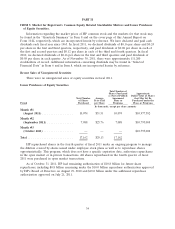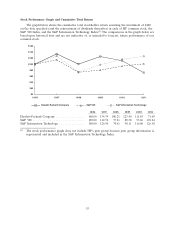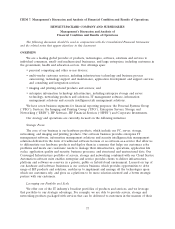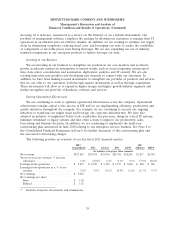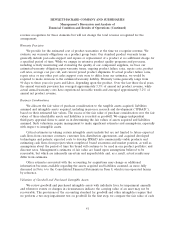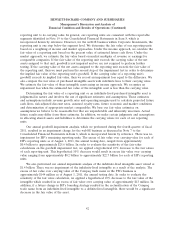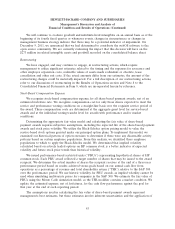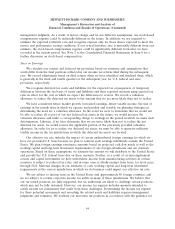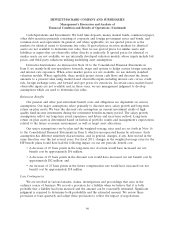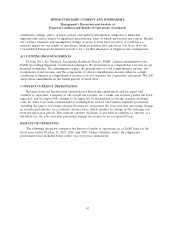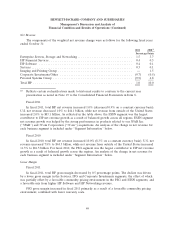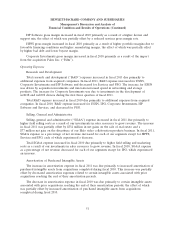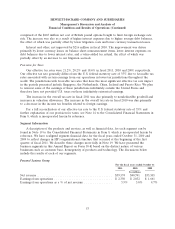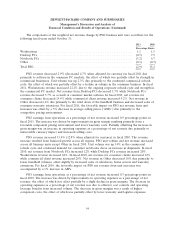HP 2011 Annual Report Download - page 52
Download and view the complete annual report
Please find page 52 of the 2011 HP annual report below. You can navigate through the pages in the report by either clicking on the pages listed below, or by using the keyword search tool below to find specific information within the annual report.HEWLETT-PACKARD COMPANY AND SUBSIDIARIES
Management’s Discussion and Analysis of
Financial Condition and Results of Operations (Continued)
management judgment. As a result, if factors change and we use different assumptions, our stock-based
compensation expense could be materially different in the future. In addition, we are required to
estimate the expected forfeiture rate and recognize expense only for those shares expected to meet the
service and performance vesting conditions. If our actual forfeiture rate is materially different from our
estimate, the stock-based compensation expense could be significantly different from what we have
recorded in the current period. See Note 2 to the Consolidated Financial Statements in Item 8 for a
further discussion on stock-based compensation.
Taxes on Earnings
We calculate our current and deferred tax provisions based on estimates and assumptions that
could differ from the final positions reflected in our income tax returns filed during the subsequent
year. We record adjustments based on filed returns when we have identified and finalized them, which
is generally in the third and fourth quarters of the subsequent year for U.S. federal and state
provisions, respectively.
We recognize deferred tax assets and liabilities for the expected tax consequences of temporary
differences between the tax bases of assets and liabilities and their reported amounts using enacted tax
rates in effect for the year in which we expect the differences to reverse. We record a valuation
allowance to reduce the deferred tax assets to the amount that we are more likely than not to realize.
We have considered future market growth, forecasted earnings, future taxable income, the mix of
earnings in the jurisdictions in which we operate and prudent and feasible tax planning strategies in
determining the need for a valuation allowance. In the event we were to determine that we would not
be able to realize all or part of our net deferred tax assets in the future, we would increase the
valuation allowance and make a corresponding charge to earnings in the period in which we make such
determination. Likewise, if we later determine that we are more likely than not to realize the net
deferred tax assets, we would reverse the applicable portion of the previously provided valuation
allowance. In order for us to realize our deferred tax assets, we must be able to generate sufficient
taxable income in the tax jurisdictions in which the deferred tax assets are located.
Our effective tax rate includes the impact of certain undistributed foreign earnings for which we
have not provided U.S. taxes because we plan to reinvest such earnings indefinitely outside the United
States. We plan foreign earnings remittance amounts based on projected cash flow needs as well as the
working capital and long-term investment requirements of our foreign subsidiaries and our domestic
operations. Based on these assumptions, we estimate the amount we will distribute to the United States
and provide the U.S. federal taxes due on these amounts. Further, as a result of certain employment
actions and capital investments we have undertaken, income from manufacturing activities in certain
countries is subject to reduced tax rates, and in some cases is wholly exempt from taxes, for fiscal years
through 2024. Material changes in our estimates of cash, working capital and long-term investment
requirements in the various jurisdictions in which we do business could impact our effective tax rate.
We are subject to income taxes in the United States and approximately 80 foreign countries, and
we are subject to routine corporate income tax audits in many of these jurisdictions. We believe that
our tax return positions are fully supported, but tax authorities are likely to challenge certain positions,
which may not be fully sustained. However, our income tax expense includes amounts intended to
satisfy income tax assessments that result from these challenges. Determining the income tax expense
for these potential assessments and recording the related assets and liabilities requires management
judgments and estimates. We evaluate our uncertain tax positions in accordance with the guidance for
44


